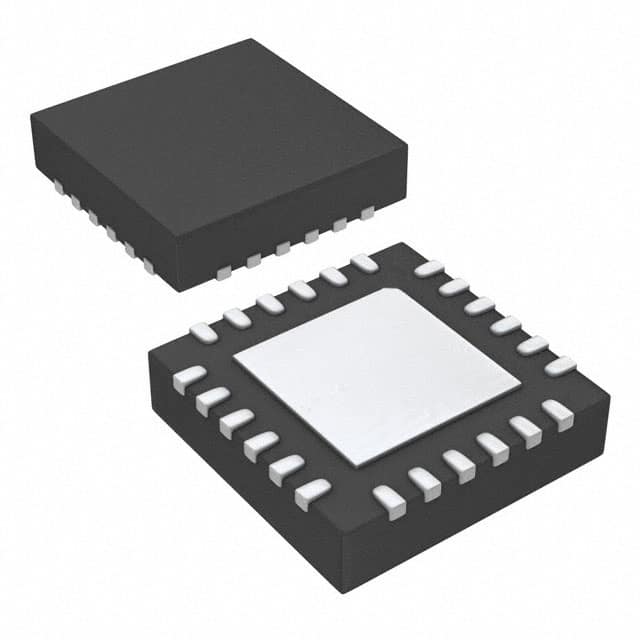SI5338Q-A-GM
Overview
Category
SI5338Q-A-GM belongs to the category of integrated circuits (ICs).
Use
It is commonly used as a clock generator and jitter attenuator in electronic devices.
Characteristics
- Provides high-performance clock signals with low jitter.
- Offers flexible frequency synthesis and distribution options.
- Supports multiple input and output formats.
- Features programmable output skew control.
- Operates at a wide range of supply voltages.
Package
SI5338Q-A-GM is available in a compact surface-mount package.
Essence
The essence of SI5338Q-A-GM lies in its ability to generate precise clock signals for various applications.
Packaging/Quantity
This product is typically packaged in reels or trays, with a quantity of 250 units per reel/tray.
Specifications and Parameters
- Input Voltage Range: 1.8V - 3.3V
- Output Frequency Range: 1MHz - 1.4GHz
- Supply Voltage: 2.5V - 3.3V
- Operating Temperature Range: -40°C to +85°C
Pin Configuration
For detailed and complete pin configuration information, please refer to the datasheet provided by the manufacturer.
Functional Characteristics
SI5338Q-A-GM offers the following functional characteristics:
- Multiple clock outputs with programmable frequencies.
- Integrated phase-locked loop (PLL) for precise frequency synthesis.
- Jitter attenuation capabilities for improved signal quality.
- Flexible input/output format support, including LVCMOS, LVDS, and LVPECL.
- Programmable output skew control for signal alignment.
Advantages and Disadvantages
Advantages
- High-performance clock generation with low jitter.
- Versatile frequency synthesis and distribution options.
- Wide operating voltage range.
- Compact package size.
- Programmable output skew control.
Disadvantages
- Limited output frequency range (up to 1.4GHz).
- Requires careful consideration of input/output format compatibility.
Applicable Range of Products
SI5338Q-A-GM is suitable for a wide range of electronic devices that require precise clock signals, such as:
- Communication equipment
- Networking devices
- Industrial automation systems
- Test and measurement instruments
- Consumer electronics
Working Principles
SI5338Q-A-GM utilizes a phase-locked loop (PLL) to generate clock signals based on the input reference frequency. The PLL locks onto the input signal and generates high-quality clock outputs with programmable frequencies and low jitter.
Detailed Application Field Plans
The detailed application field plans for SI5338Q-A-GM can vary depending on the specific requirements of the electronic device it is used in. Some common applications include:
- Clock generation for high-speed data communication systems.
- Synchronization of multiple devices in a network.
- Timing control in industrial automation processes.
- Clock distribution in test and measurement setups.
- Clock synchronization in audio/video processing systems.
Detailed Alternative Models
There are several alternative models available in the market that offer similar functionality to SI5338Q-A-GM. Some notable alternatives include:
- SI5341A-B-GM
- MAX038CPP
- AD9520-3BCPZ
- CY27410SXC-2T
- LTC6957CMS-2
5 Common Technical Questions and Answers
Q: What is the maximum output frequency of SI5338Q-A-GM? A: The maximum output frequency is 1.4GHz.
Q: Can SI5338Q-A-GM operate with a supply voltage below 2.5V? A: No, the recommended supply voltage range is 2.5V - 3.3V.
Q: Does SI5338Q-A-GM support LVPECL output format? A: Yes, it supports LVPECL, as well as other common formats like LVCMOS and LVDS.
Q: Can the output skew be adjusted programmatically? A: Yes, SI5338Q-A-GM offers programmable output skew control.
Q: What is the operating temperature range of SI5338Q-A-GM? A: It can operate within a temperature range of -40°C to +85°C.
This encyclopedia entry provides an overview of SI5338Q-A-GM, including its category, use, characteristics, package, essence, packaging/quantity, specifications and parameters, pin configuration, functional characteristics, advantages and disadvantages, applicable range of products, working principles, detailed application field plans, detailed alternative models, and answers to five common technical questions.


